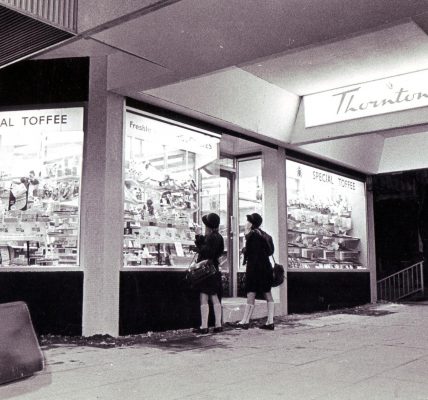"Everything was in ruins…" memories of the Hull Blitz 80 years on
Frank Inman was just nine years old when the Luftwaffe unleashed its wrath on Hull in the spring of 1941, but he remembers it vividly.
Like so many other children at the time, he had been evacuated to the relative safety of the countryside. But while some youngsters revelled in this new found freedom, Frank didn’t get on with the family he was staying with in Sutton upon Derwent, a small village near York, and a year later he ran away trekking 30 miles back to his family’s home in Hull – at the very moment the city was being pummelled.
“I wanted to go back to Hull and by hook or by crook I got there. I walked all through the night and I got lifts on farm wagons and tractors,” he recalls.
He was guided back home by the fires glowing in the looming distance. “I remember sleeping in a haystack on Market Weighton Hill, watching the fires. Friday night was the big blitz and it was the Saturday morning when I got back to Hull.”
His mother, not surprisingly, was shocked to see him. “I knew my mum would be going shopping so I waited for her at the bus stop and at 11 o’clock, sure enough there she was. But rather than getting a hug or a kiss I got a clip round the ear.”
It was London that was shaken first by the Blitz in 1940, but by the following spring the Nazis had identified other strategic targets, and the vital port of Hull was near the top of their list.
The Luftwaffe attacks intensified in March and April 1941, when the city was targeted in a series of particularly heavy raids.
This, though, was a prelude to what became known locally as the Hull Blitz when several nights of terror starting on May 7, left at least 420 people dead and a further 350 seriously injured.
Overnight between May 7 and 8, more than 70 German aircraft dropped over 100 tonnes of high explosives, as well as more than 9,000 incendiary bombs. Even worse was to follow.
Between midnight on May 8 and 3.40am on May 9, a total of 120 bombers dropped more than 150 tonnes of high explosives and nearly 20,000 incendiaries.
As well as being bombed because other targets could not be found or were too well protected, Hull’s docks, industry and railways were key targets themselves.
Frank remembers the scenes of devastation in the wake of these bombing raids. “You could see all the way down the River Hull and the warehouses were burning. We lived on the east side of the city about a mile-and-a-half from King George’s Dock and when I got home they were still ablaze.”
It was more than a week before he ventured into the city centre, but when he did he was greeted by a scene of destruction. “Everything was in ruins. You couldn’t walk anywhere without seeing a building damaged or a street cordoned off because of unexploded bombs.”
For Frank, and many of his peers, the war was a bit of an adventure, and he went around bomb sites with his homemade go-kart, or “bogey” as they were known, collecting shrapnel.
He recalls on other occasions seeing the approaching German bombers. “You’d hear them coming over and you could see them heading down the river, it had a silver sheen and they used it to guide them. I could tell by seeing a plane coming in, and I saw up to 50 bombers at a time, whether it was coming here or going over to Sheffield. You knew if they were flying low that Hull was going to get it,” he says.
Mike Ulyatt and his wife, Ann, were young children living in Hull at the time, and they have a personal connection to the blitz. Ann inherited a black and white photo taken inside a pub featuring a man and his wife and three barmen.
They knew little about the picture until they saw another photograph of the man at an exhibition at Hull’s Carnegie Heritage Centre. “There was a note saying if anybody recognises this gentleman to ring this number, so we did,” says Mike.
They discovered the couple in the photograph were Frederick Wallis and Catherine Wallis, Ann’s great aunt and uncle. “It turned out this photograph was taken in the Punch Hotel in Hull and on the night of the 7th and 8th of May the police warned them about a raid, so rather than sheltering in the pub’s cellar they went to the Prudential Insurance building which was across the road.”
The Prudential tower on Queen Victoria Square took a direct hit killing, among others, Fred and Catherine, along with their three children, including their eldest daughter who was pregnant. “The tragedy is if they’d stayed in the pub they would have been safe.”
Mike lived with his family in the Sculcoates area of the city. “We were 50 yards from the Hull and Barnsley railway line which brought coal to the power station that was about 400 yards from where we lived. It’s only later that you look at the bomb damage and think, ‘there but for the grace of God,’” he says.
“We had communal air raid shelters on our street. I can remember my mother grabbing me up in the cold of night when the air raid alarms went off and taking me into the shelter. It felt like a big adventure, there were bunk beds and other kids and jam sandwiches. But I can remember the air raid shelter shuddering and people screaming.”
As the bombing raids intensified those living in the heart of the city suffered the most, as Sheila Coates remembers. “We were the last house in Hedon and in front of us were fields where cows were kept, and on a night people from east Hull were bused out and they would sleep in the field.
“If you had a spare bedroom you took someone in and then in the morning they would all go back to Hull. As the bombs got worse people wanted to stay so pigsties and sheds were turned into houses.”
Reports at the time didn’t mention Hull by name in order to divert attention and play down its significance, and instead it was referred to obliquely as a “North-East town”. Hull had been the subject of a “D Notice” – a voluntary request to the Press not to disclose certain information for reasons of national security, as the Cabinet was concerned the city’s suffering would lower national morale.
The sheer scale of the destruction only became apparent after the war was over, when it emerged that Hull was the second most bombed city in England after London.
More than 1,200 people had been killed in 82 bombing raids on Hull during the war, while figures show that 86,715 homes were damaged – 94 per cent of the entire housing stock – and 152,000 people were made temporarily homeless, more than half the city’s population.
These are, of course, the stark statistics. Behind each one is a story, a life lost, a family left bereft, and a world that would never be the same again.










